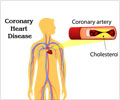Residents in New Orleans are facing a three-fold increased risk of heart attack post Katrina, finds research.

"Overwhelmingly, the main differences in the pre- and post-Katrina populations involve psychosocial risk factors as opposed to shifts in traditional cardiovascular risk factors like hypertension, obesity and diabetes," said Anand Irimpen, MD, the study's senior investigator, associate professor of medicine at the Heart and Vascular Institute of Tulane University School of Medicine and chief of cardiology at the Southeast Louisiana Veterans Health Care System. "These findings have broad implications about how natural disasters affect communities, as well as the extensive costs to society, whether it is financial or social."
Dr. Irimpen said the evidence supports an association between pervasive levels of chronic stress and heart health and underscores the need for clinicians to proactively assess their patients' anxiety levels, especially in the aftermath of such a traumatic event. Previous studies indicate stress reduction and cognitive behavioral therapy, in particular, may reduce the occurrence of heart attacks.
This study evaluated patients admitted with heart attacks to Tulane Medical Center in the two years before Katrina and the six years after the hospital reopened, which was five months after Katrina. Researchers examined differences in the incidence of heart attacks and compared the two groups based on specific demographic and clinical data, including lab test results, health insurance status, first-time hospitalization, medical non-adherence, smoking status, substance abuse and employment. In the post-Katrina group, there were 1,177 confirmed admissions for heart attack representing 2.4 percent of the total patient census of 48,258 compared to 150 admissions representing 0.7 percent of the patient census of 21,079 in the two-year pre-Katrina group (p<0.0001).
The groups were comparable in terms of age, sex, ethnicity and hypertension. However, the post-Katrina group had a higher prevalence of prior coronary artery bypass grafts, hyperlipidemia, psychiatric comorbidities like depression and anxiety disorder, as well as smoking and substance abuse. This group was also more likely to be unemployed, uninsured and reside in New Orleans. While there seems to be a higher proportion of people with coronary artery disease post-Katrina, Dr. Irimpen says this increase may be secondary to the surge in heart attacks. The prevalence of known coronary artery disease among thesepatients was 42, 48 and 53 percent at two, four and six years after the storm, respectively. It was 30.7 percent pre-Katrina, suggesting that people may not be adequately controlling cardiovascular risk factors.
"Large-scale catastrophes like Hurricane Katrina seem to create a very large shift in the population and the way it behaves and takes care of itself," he said. "While there is a lot we can do with medications and medical interventions, those therapies become less effective based on the way the patient takes care of him or herself."
Advertisement
"The massive devastation of Hurricane Katrina has broken the infrastructure of New Orleans, and its effects are much more far-reaching than we expected," Dr. Irimpen said, adding that ongoing implementation of lifestyle changes to help accommodate for unforeseen circumstances is imperative for maintaining heart health.
Advertisement
Source-Eurekalert














